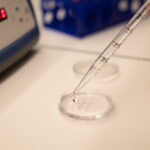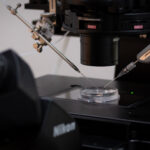Becker Equine provides a broad range of reproductive services such as:
- Stallion semen collection, evaluation, shipping and freezing
- Semen storage
- Breeding evaluation / Cycle check / Pregnancy check
- Embryo flush / transfer / freezing / Thawing
- ICSI (Intracytoplasmic Sperm Injection)
- Oocyte collection.
What is ICSI?
ICSI stands for Intracytoplasmic Sperm Injection. It is an in vitro fertilization technique used in animal reproduction. The goal is to provide the ability to reproduce while still performing or when they are no biologically able to carry a pregnancy. It is also used to increase the number of animal product with high commercial value.
The technique consists of injecting a single sperm inside the egg, and fresh or frozen semen of low quality or high commercial value can be used. Embryos cultured in the laboratory, within approximately 10 days, are evaluated and transferred to a recipient mare or frozen.
What is the advantage of harvesting oocytes from a mare and doing ICSI instead of an embryo transfer?
- Some mares may be unable to reproduce (chronic uterine infections, severe cervical abnormalities, obstructed oviducts, anovulatory follicles, or other medical conditions that prevent the mare to provide a healthy environment for the embryo).
- Sore mares might not be able to carry due to a medical condition (fractured pelvis, old age, pre-pubic ligament tear, chronic lamenesses)
- Stallions with low seminal quality, high value animals that died and can be optimized.



Success rates
- 60-70% of aspirated follicles result in oocytes.
- 50-60% of the oocytes reach maturation and are injected;
- Approximately 20-30% of injected eggs develop into viable blastocysts;
- Pregnancy rate of transferred embryos is around 60%;
- Up to 90 days of gestation, the rate of embryonic loss from ICSI is about 15-20%.
- Results may vary depending on factors related to the mare or stallion, such as:
- age of the mare;
- Seminal quality;
- Breeding season period.
Source: genetechvet.com
